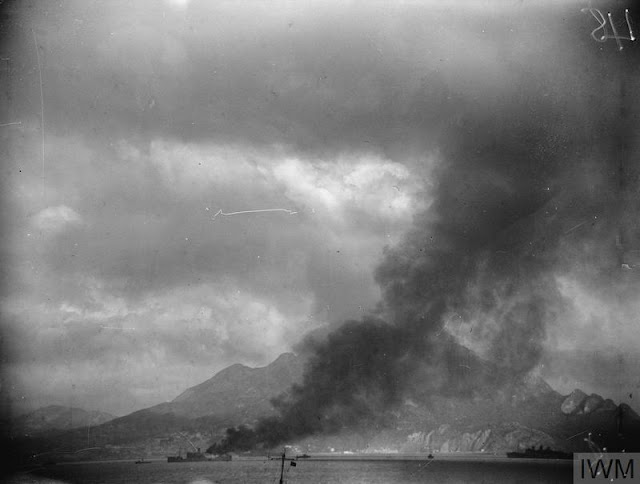Operation TORCH, Invasion of North Africa, 1942
Landings on Three Fronts, Busy Times.
[Photo: A13015. A boatload of British troops in a landing craft off Bougie, Algeria.
Photo Credit - RN Photographer, Lt. L. Pelman, Imperial War Museum, IWM]
Introduction:
Canadians in Combined Operations performed ferrying duties (transporting British and American troops and all the materials of war to shore) for about two weeks beginning on D-Day November 8. They were stationed aboard troop and supply ships at two fronts near Oran and Algiers and transported their significant loads in LCAs (landing craft, assault) and LCMs (landing craft, mechanized).
In the book "Combined Operations" by Londoner Clayton Marks we read the following, from files of Canadian Lt. Cdr. J.E. Koyl (D.S.C., RCNVR):
Shortly after Dieppe, the Canadian Flotillas, now six in number, were making their preparations for a new operation which subsequently turned out to be "Operation Torch" eg. the North African invasion. For several weeks the British and American troops were trained in amphibious warfare and on completion of this training, the invasion was completed successfully.
This operation, as compared to Dieppe, was a complete holiday as the opposition in most quarters was negligible. By the middle of December, 1942, the Canadian Flotillas were returning to England.
The H.M.S. Ettrick was sunk off Cadiz with the loss of 18 Canadians. Survivors were picked up by a Norwegian destroyer and returned to Gibraltar. The S.S. Clan McTaggart was also sunk in approximately the same area with the loss of 1 Canadian. Picked up survivors were returned to England aboard a British corvette.
On their return to England and by early January they were re-organized into 4 Flotillas, the 55th and 61st manning LCA's and the 80th and 81st manning LCM's.
On their return to England and by early January they were re-organized into 4 Flotillas, the 55th and 61st manning LCA's and the 80th and 81st manning LCM's.
Once again preparations were being made for another operation and by the end of May, 1943, the four Flotillas arrived in Egypt. Further exercises were carried out and finally came the invasion of Sicily and the operation in Italy.
The Canadian Flotillas at all times performed their duties in a manner which brought the highest of praise from our Commanding Officer, Admiral Troubridge, Admiral of the force. (Page 174, Combined Operations.)
This entry focusses on 16 photographs and their full captions as found at the Imperial War Museum (IWM, U.K.). They were taken by Royal Navy photographers and there are likely more that I have been unable to locate. Full credit is listed with the photos.
This entry focusses on 16 photographs and their full captions as found at the Imperial War Museum (IWM, U.K.). They were taken by Royal Navy photographers and there are likely more that I have been unable to locate. Full credit is listed with the photos.
Readers can search (endlessly, 11 million photographs) by going to Search our Collections, IWM.
A13016. Heading - North Africa Operations. 12 November 1942, British troop
convoy beaches at Bougie, Algeria. Caption - British troops disembarking from LCPs
during the landing at Bougie, Algeria. RN Photographer, Lt. L. Pelman, IWM.
A13017. SS KARANJA and SS CATHAY on fire off Bougie.
Photo - RN Photographer, Lt. L. Pelman, IWM.
A13018. SS KARANJA and SS CATHAY on fire off Bougie.
Photo Credit - RN Photographer, Lt. L. Pelman, IWM.
A13019. SS KARANJA and SS CATHAY on fire off Bougie.
RN Photographer, Lt. L. Pelman, IWM.
A13021. Survivors from SS AWATEA, which was bombed and torpedoed outside
Bougie Bay, on board the ST MARNIX. RN Photographer, Lt. L. Pelman, IWM.
A13024. Heading - The troop convoy en route to Gibraltar. Caption - Troop
convoy en route for Gibraltar with HMS BITER, an escort carrier, nearest
the camera. Photo Credit - Admiralty Official Collection*
the camera. Photo Credit - Admiralty Official Collection*
*Editor's Note: The above caption does accompany Photo A13024 at the Imperial War Museum but I suspect there has been some mixup. An accordion, not "an escort carrier", appears to be "nearest the camera"!
A13034. Heading - THE BRITISH NAVY IN NORTH AFRICAN OPERATIONS.
20 NOVEMBER 1942, THE BRITISH NAVY PLAYED A LARGE PART IN THE
NORTH AFRICAN COMBINED OPERATION. HMS NELSON anchored
off Mers-el-Kebir. Photo Credit - Lt. C.H. Parnall, IWM
A13035. HMS RODNEY and destroyers off Mers-el-Kebir.
Photo Credit - RN Photographer Lt. C.H. Parnall, IWM.
A13036. Heading - The British Navy in North African operations.
20 November 1942. The British Navy played a large part in the North
African Combined Operation. Caption - HMS Sirius off Oran.
Photo - Lt. C.H. Parnall, IWM.
A13037. Heading as above. Caption - HMS SIRIUS, HMS FORMIDABLE, and
HMS RODNEY entering Mers-el-Kebir harbour. Photo - Lt. C.H. Parnall, IWM
A13038. HMS RODNEY and HMS SIRIUS off Oran.
Photo Credit - RN Photographer Lt. C.H. Parnall IWM
A13039. HMS SIRIUS at Oran, with a French tug in the foreground.
Photo - Lt. C.H. Parnall, Imperial War Museum (IWM)
A13040. HMS NELSON and HMS RODNEY anchored off Mers-el-Kebir.
Photo - Lt. C.H. Parnall, IWM.
A13042. Heading - The British Navy in North African operations. 20 NOV. 1942.
A 'Sea-Dog' guards the depth charges. Caption - 'Buds', the ships mascot of the
British destroyer BOREAS. Photo Credit - Lt. C.H. Parnall, IWM.
A 'Sea-Dog' guards the depth charges. Caption - 'Buds', the ships mascot of the
British destroyer BOREAS. Photo Credit - Lt. C.H. Parnall, IWM.
A13045. HM Ships anchored off Mers-el-Kebir.
Royal Navy Photographer Lt. C.H. Parnall, IWM.
Royal Navy Photographer Lt. C.H. Parnall, IWM.
One more round of 'found photos' to follow.
















No comments:
Post a Comment